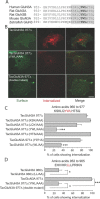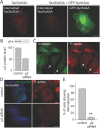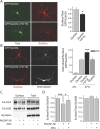Tyrosine phosphorylation regulates the endocytosis and surface expression of GluN3A-containing NMDA receptors
- PMID: 23447623
- PMCID: PMC3682218
- DOI: 10.1523/JNEUROSCI.2721-12.2013
Tyrosine phosphorylation regulates the endocytosis and surface expression of GluN3A-containing NMDA receptors
Abstract
Selective control of receptor trafficking provides a mechanism for remodeling the receptor composition of excitatory synapses, and thus supports synaptic transmission, plasticity, and development. GluN3A (formerly NR3A) is a nonconventional member of the NMDA receptor (NMDAR) subunit family, which endows NMDAR channels with low calcium permeability and reduced magnesium sensitivity compared with NMDARs comprising only GluN1 and GluN2 subunits. Because of these special properties, GluN3A subunits act as a molecular brake to limit the plasticity and maturation of excitatory synapses, pointing toward GluN3A removal as a critical step in the development of neuronal circuitry. However, the molecular signals mediating GluN3A endocytic removal remain unclear. Here we define a novel endocytic motif (YWL), which is located within the cytoplasmic C-terminal tail of GluN3A and mediates its binding to the clathrin adaptor AP2. Alanine mutations within the GluN3A endocytic motif inhibited clathrin-dependent internalization and led to accumulation of GluN3A-containing NMDARs at the cell surface, whereas mimicking phosphorylation of the tyrosine residue promoted internalization and reduced cell-surface expression as shown by immunocytochemical and electrophysiological approaches in recombinant systems and rat neurons in primary culture. We further demonstrate that the tyrosine residue is phosphorylated by Src family kinases, and that Src-activation limits surface GluN3A expression in neurons. Together, our results identify a new molecular signal for GluN3A internalization that couples the functional surface expression of GluN3A-containing receptors to the phosphorylation state of GluN3A subunits, and provides a molecular framework for the regulation of NMDAR subunit composition with implications for synaptic plasticity and neurodevelopment.
Figures








Similar articles
-
GluN3A: an NMDA receptor subunit with exquisite properties and functions.Neural Plast. 2013;2013:145387. doi: 10.1155/2013/145387. Epub 2013 Dec 9. Neural Plast. 2013. PMID: 24386575 Free PMC article. Review.
-
Casein kinase 2 regulates the NR2 subunit composition of synaptic NMDA receptors.Neuron. 2010 Sep 23;67(6):984-96. doi: 10.1016/j.neuron.2010.08.011. Neuron. 2010. PMID: 20869595 Free PMC article.
-
Phospho-regulation of synaptic and extrasynaptic N-methyl-d-aspartate receptors in adult hippocampal slices.Neuroscience. 2009 Feb 18;158(4):1446-59. doi: 10.1016/j.neuroscience.2008.11.006. Epub 2008 Nov 8. Neuroscience. 2009. PMID: 19041929
-
Cdk5 regulates the phosphorylation of tyrosine 1472 NR2B and the surface expression of NMDA receptors.J Neurosci. 2008 Jan 9;28(2):415-24. doi: 10.1523/JNEUROSCI.1900-07.2008. J Neurosci. 2008. PMID: 18184784 Free PMC article.
-
GluN3A NMDA receptor subunits: more enigmatic than ever?J Physiol. 2022 Jan;600(2):261-276. doi: 10.1113/JP280879. Epub 2021 May 31. J Physiol. 2022. PMID: 33942912 Review.
Cited by
-
Dynamic Regulation of N-Methyl-d-aspartate (NMDA) and α-Amino-3-hydroxy-5-methyl-4-isoxazolepropionic Acid (AMPA) Receptors by Posttranslational Modifications.J Biol Chem. 2015 Nov 27;290(48):28596-603. doi: 10.1074/jbc.R115.652750. Epub 2015 Oct 9. J Biol Chem. 2015. PMID: 26453298 Free PMC article. Review.
-
GluN3A expression restricts spine maturation via inhibition of GIT1/Rac1 signaling.Proc Natl Acad Sci U S A. 2013 Dec 17;110(51):20807-12. doi: 10.1073/pnas.1312211110. Epub 2013 Dec 2. Proc Natl Acad Sci U S A. 2013. PMID: 24297929 Free PMC article.
-
The roles of GluN3-containing N-methyl-D-aspartate receptor in central nerve system.Zhejiang Da Xue Xue Bao Yi Xue Ban. 2021 Oct 25;50(5):651-658. doi: 10.3724/zdxbyxb-2021-0167. Zhejiang Da Xue Xue Bao Yi Xue Ban. 2021. PMID: 34986531 Free PMC article. Review. English.
-
GluN3A: an NMDA receptor subunit with exquisite properties and functions.Neural Plast. 2013;2013:145387. doi: 10.1155/2013/145387. Epub 2013 Dec 9. Neural Plast. 2013. PMID: 24386575 Free PMC article. Review.
-
DYRK1A-mediated phosphorylation of GluN2A at Ser(1048) regulates the surface expression and channel activity of GluN1/GluN2A receptors.Front Cell Neurosci. 2014 Oct 17;8:331. doi: 10.3389/fncel.2014.00331. eCollection 2014. Front Cell Neurosci. 2014. PMID: 25368549 Free PMC article.
References
Publication types
MeSH terms
Substances
Grants and funding
LinkOut - more resources
Full Text Sources
Other Literature Sources
Molecular Biology Databases
Research Materials
Miscellaneous
